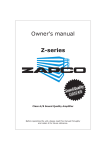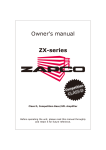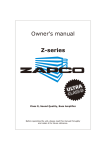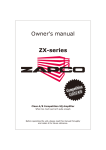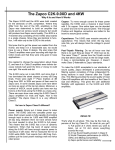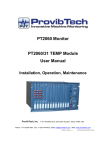Download zapco STUDIO 100 Owner`s manual
Transcript
Owner's manual ST-series D Great Sound - Big Power - Compact Chassis Before operating the unit, please read this manual throughly and retain it for future reference. Protect your Investment Note your information below for reference: Model # Serial # Date Purchased And: Register your Zapco product now At: www.zapco.com Mission Statement Committed to Excellence Zapco is dedicated to the pursuit of audio fidelity. Our prime objectives are to design and manufacture audio products of unsurpassed quality, to provide unparalleled support and service for these products, and to conduct business in a manner that will enhance the quality of life for all involved. Experience: Knowledge from Doing There is absolutely no substitute for experience; that is a simple fact of life. Another simple fact is that Zapco has, for over forty years, been the leader in defining quality standards for the car audio industry. These years of experience have led to a thorough understanding of the challenges that are unique to the world of car audio. Zapco's relentless quest for sonic purity consistently yields imaginative designs that utilize the most innovative technologies. The resulting products set the criteria by which all others in the industry are judged. The ST-Series D Full range Class D Amplifiers Zapco introduced the industry to great sounding Class D amplifiers some 10 years ago with the famous C2K-9.0XD. In those days, the filtering and control systems needed to make Zapco sound quality in a Class D amplifier meant it had to be expensive and it had to be big. Today's technology, however, has allowed us to develop a line of great sounding full range Class D amps at an affordable price range and in a size that's an easy fit in today's smaller cars. Small car doesn't have to mean small sound, and you won't have to give up the back seat for an amplifier. And even motorcycles. In fact, at only 6.3" x 6.7", the ST2D is the ideal amplifier for a motorcycle. Small size, big power. And talk about POWER! This tiny little monster is going to give you 400watts RMS. With that kind of power on your bike, you're going to need louder pipes, and, since these little power houses are Zapco amps, you know they're going to sound great. Just like with the Z-Series and the ZX-Series, we kept the ST-D series simple. The feature set is kept to the essentials. They all have 18dB crossovers, speaker level inputs, and optional remote level controls, but, they don't have chrome or fancy paint jobs, and they don't look like hot rod engines or computers. They look like car audio amplifiers. We put our efforts (and your money) into great sound and reliable power. Even though they're Class D they have less than 0.05% THD+noise and 90dB signal to noise ratio. After all, loud is no good unless it sounds great as well. And these new amplifiers sound awesome. Audition one today and you'll know what we mean. And, though the 2ch, 4ch, and 5ch powerhouses have way more punch than you'd expect from such a diminutive chassis, we know you're going to want dedicated bass amps as well. And the ST-D series has 'em! You can choose 500 watts at 1 ohm or 1,000 watts at 1 ohm, and even the 1,000 watt amp is less than 10" long. Power and Wire Gauge The wire you use for the power and ground connections of your amplifier is absolutely critical. The plain simple fact is that it takes power to deliver power. If you do not provide the proper amount of 12V power to your amplifier, you will never reach the full power potential of the amp. Take a look at the chart below. If you want to have any respectable amount of power for your amp, you need a 4-gauge wire to the trunk as a bare minimum. If you are running any Zapco Z-series amp in you trunk you need at least a 2 gauge wire. If you want enough power to drive woofers, you’re certainly going to need at least a 2-gauge wire to the rear and zero gauge is better. Recommended Wire Gauge Up to 20 A 35 A 50 A 60 A 85 A 105 A 125 A 150 A 4 Ft 14 12 10 8 4 4 4 2 7 Ft 12 10 8 8 4 4 4 2 10 Ft 12 8 8 4 4 4 4 2 13 Ft 10 8 4 4 4 2 2 2 16 Ft 10 4 4 4 2 2 2 0 19 Ft 8 4 4 4 2 2 0 0 22 Ft 8 4 4 4 2 2 0 0 28 Ft 8 4 4 2 0 0 0 0 You can certainly save money by buying cheap small gauge wire, but remember...It will cost you in power and may even damage your car by passing too much current and causing shorts or even fires. Protect your investment in Zapco amplifiers by using high quality, proper gauge wire. And remember... Current in the amplifier runs in a complete circuit from the battery to the amp and back to the battery through the chassis and frame. The ground wire us just as important as the power input wire. Positive and Negative connections must always use the same gauge wire. Installation Guidelines Mounting your ST-Series Amplifier is easy. Keep in mind the following guidelines: The amplifier may be mounted in any direction, on wood, metal or carpet. The metal case of the amplifier may be grounded or left isolated. The amplifier requires adequate ventilation. Position the amplifier with sufficient surrounding area for proper cooling. Keep fan and vent endplates clear for proper internal cooling. Keep the amplifier out of the engine compartment and other locations that may cause excessive heat or moisture. Make sure your ground point is at the frame or a chassis point with direct frame contact. Note: the "quiet metal" on many new cars make body panels very bad ground points, so always try to use the frame. Do not mount the amplifier to a subwoofer enclosure or any other place that may have excessive vibration! -3- Gain Setting Matching Your Components for Best Sound Proper gain setting is one of the most important factors in setting up a stereo system. Unfortunately, gain setting is quite often done wrong. Turning up the gain of an amp is the very last thing you should ever do to a system. An amplifier is a step up transformer. Period. Any signal you put in is boosted by a fixed factor, whether it's music, hiss, or any other noise. A large number of noise problems are simply a matter of improper gain settings. The goal of gain setting is to achieve the maximum amount of musical output from the amplifier while getting the least amount of hiss or noise from the system. Your ST-Series amplifier accepts an extremely wide range of input levels. As little as .5 volts on the RCAs to as much as 8 volts. The basic gain setting is very simple and requires no special tools. Whether you have a simple system with a deck and an amp, or a system with a deck, line driver, equalizer, crossover, and amp, the procedure is always the same. First, hook up the system with all gain controls at minimum (turn the gain pot fully counter-clockwise with a small screwdriver). Then turn on the head unit and turn up the volume. If you achieve clean sound, and, more volume than you want, you don’t need to make any adjustments. However, if you turn up the volume and begin to hear distorted sound before it becomes loud, you are clipping (distorting) the deck (probably a little over ¾ volume). Turn the deck down just enough to hear clean sound again, and then move to the next component in your system. With the deck playing at “maximum clean volume” adjust the gain of the next component to its “maximum clean volume”. If you adjust your gains this way, always starting at the head unit and working down the line to the amplifier, you will get the most performance out of your amplifier(s) with the least amount of unwanted distortion and noise. Presenting The Zapco Studio-D Series Amplifiers -4- FEATURES ST-2D High efficiency Class D amplifier (efficiency : 80% @ 4 ohm, at 1kHz) 2/1 channel bridgeable car amplifier Ultra low power consumption Ultra compact heatsink Stable into 4 ohms bridged or 2 ohms stereo load PWM MOSFET power supply Input sensitivity (gain) control variable 18dB octave crossover slope Variable,selectable FULL / LP/ HP crossover 12 dB bass boost equalization control variable Signal input and output RCA connectors High level input connectors Multi-way protection circuitry (thermal / over current / speaker short / speaker DC protection) Tested voltage & THD: 14.4V & less than 0.05% THD Operating voltage : DC10V~15.5V power input ST-4D High efficiency Class D amplifier (efficiency : 80% @ 4 ohm, at 1kHz) 4/3/2 channel bridgeable car amplifier Ultra low power consumption Ultra compact heatsink Stable into 4 ohms bridged or 2 ohms stereo load PWM MOSFET power supply Input sensitivity (gain) control variable 18dB octave crossover slope Variable, selectable FULL/ LP / HP crossover 2 dB bass boost equalization control variable Signal input RCA connectors High level input connectors Multi-way protection circuitry (thermal / over current / speaker short / speaker DC protection) Tested voltage & THD: 14.4V & less than 0.05% THD Operating voltage : DC10V~15.5V power input -3- FEATURES ST-5D High efficiency Class D amplifier (efficiency : 80% @ 4 ohm, at 1kHz) 5/3 channel bridgeable car amplifier Ultra low power consumption Ultra compact heatsink MOS-FET PWM power supply 4 ohm bridged or/and 2 ohm stereo load 18dB octave crossover slope Variable low pass filter Variable high pass filter Variable subsonic filter Signal input RCA connectors High level input connectors Multi-way protection circuitry (thermal / over current / speaker short / speaker DC protection) Tested voltage & THD: 14.4V & less than 0.05% THD Operating voltage : DC10V~15.5V power input ST-500DM High efficiency Class D amplifier (efficiency : 80% @ 4 ohm, at 1kHz) Ultra low power consumption Ultra compact heatsink MOS-FET PWM power supply High level input connectors Multi-way protection circuitry (thermal / over current / speaker short / speaker DC protection) Tested voltage & THD: 14.4V & less than 0.1% THD Operating voltage : DC10V~15.5V power input Wired remote controller ST-1KDM High efficiency Class D amplifier (efficiency : 80% @ 4 ohm, at 1kHz) Ultra low power consumption Ultra small sized heatsink MOS-FET PWM power supply High level input connectors Multi-way protection circuitry (thermal / over current / speaker short / speaker DC protection) Tested voltage & THD: 14.4V & less than 0.1% THD Operating voltage : DC10V~15.5V power input Wired remote controller -4- RCA CONNECTION ST-2D OUTPUT CH1 HI-INPUT GAIN FREQ BASS ST-2D INPUT CH1 + - - + CH1 CH2 MIN MAX 50Hz LPF CH2 FULL 250Hz 0dB 12dB HPF CH2 to INPUT of ADDITIONAL AMPLIFIERS HEAD UNIT ST-4D INPUT CH1 CH3 HI-INPUT GAIN FREQ BASS ST-4D CHANNEL 1/2 + - - + CH1 CH2 MIN MAX MIN MAX LPF FULL HPF 50Hz 250Hz 0dB 12dB 50Hz 250Hz 0dB 12dB CH3- CH4 + - + CH2 CH4 HI-INPUT GAIN FREQ CHANNEL 3/4 BASS HEAD UNIT Connect your source unit to the amplifier using the "INPUT" RCA connectors. The "OUTPUT" connector can be used to pass the input signal to another amplier. For Initial Setup: Always set bass boost to 0dB, and set the amplifier gain to minimum (8V sensitivity). Remember: amp gain is not a volume control. It is used only to match your amplifier input sensitivity to your source unit output. -5- RCA CONNECTION ST-5D CHANNEL 5 CHANNEL 1/2 HI-INPUT GAIN HPF SUBSONIC LPF INPUT CH5A ST-5D INPUT CH1 CH3 + - - + CH1 CH2 MIN MAX FULL HPF 50Hz 1KHz 10Hz 60Hz CH3- CH4 + - + MIN CH2 30Hz 250Hz CH5A + - CH5B - + MAX 100Hz 2KHz CHANNEL 3/4 CH4 MIN MAX GAIN HI-INPUT CH5B HEAD UNIT ST-500DM / ST-1KDM HI-IN PUT CH1/L REMOTE GAIN + - - + CH1 CH2 Min Max CH2/R Wired Remote Control (optional) HEAD UNIT Connect your source unit to the amplifier using the "INPUT" RCA connectors. Remember: amp gain is not a volume control. It is used only to match your amplifier input sensitivity to your source unit output. -6- HIGH LEVEL INPUT CONNECTION ST-2D OUTPUT CH1 HI-INPUT GAIN FREQ BASS ST-2D INPUT CH1 + - - + CH1 CH2 MIN MAX 50Hz LPF CH2 FULL 250Hz 0dB 12dB HPF CH2 CH2+ HEAD UNIT CH2 CH1 CH1+ from HEAD UNIT SPEAKER TERMINALS ST-4D INPUT CH1 CH3 HI-INPUT GAIN FREQ BASS ST-4D CHANNEL 1/2 + - - + CH1 CH2 MIN MAX MIN MAX LPF FULL HPF 50Hz 250Hz 0dB 12dB 50Hz 250Hz 0dB 12dB CH3- CH4 + - + CH2 CH4 HI-INPUT GAIN FREQ CHANNEL 3/4 BASS HEAD UNIT CH4+ CH2+ CH4 - CH2 - CH3 - CH1 CH1+ CH3+ from HEAD UNIT SPEAKER TERMINALS Caution If the HIGH LEVEL INPUTS are used, do not use the LOW LEVEL RCA inputs at the same time. -7- HIGH LEVEL INPUT CONNECTION ST-5D CHANNEL 5 CHANNEL 1/2 HI-INPUT GAIN HPF SUBSONIC LPF INPUT CH5A ST-5D INPUT CH1 CH3 + - - + CH1 CH2 MIN MAX FULL HPF 50Hz 1KHz 10Hz 60Hz CH3- CH4 + - + MIN CH2 30Hz 250Hz CH5A + - CH5B - + MAX 100Hz 2KHz CHANNEL 3/4 CH4 HEAD UNIT MIN MAX GAIN HI-INPUT CH5B CH5A+ CH5ACH5BCH5B+ CH4+ CH2+ CH4 - CH2 - CH3 - CH1 CH1+ CH3+ from HEAD UNIT SPEAKER TERMINALS ST-500DM / ST-1KDM HI-IN PUT CH1/L REMOTE GAIN + - - + CH1 CH2 Min Max CH2/R CH2+ HEAD UNIT CH2 CH1 CH1+ from HEAD UNIT SPEAKER TERMINALS Caution If the HIGH LEVEL INPUTS are used, do not use the LOW LEVEL RCA inputs at the same time. -8- POWER CONNECTION ST-2D / ST-4D / ST-5D / ST-500DM/ ST-1KDM GND REM B+ POWER INPUT GROUND Caution This amplifier is not supplied with internal fuse in itself. Make sure you install in-line fuse holder from the +terminal of battery. Recommend 70 Ampere fuse.(ST-2D) Recommend 100 Ampere fuse.(ST-4D) Recommend 150 Ampere fuse.(ST-5D) Recommend 100 Ampere fuse.(ST-500DM) Recommend 200 Ampere fuse.(ST-1KDM) to REMOTE Turn-on from HEAD UNIT HEAD UNIT BATTERY GROUND +12V Power Disconnect the Battery ground. Connect the +12V terminal of the amplifier to the + terminal of the battery using the appropriate guage wire cable. Always use the same guage wire for Power and Ground. Install an in-line fuse holder, within approximately 14" of the + terminal of battery. GROUND Connect the GND (ground) terminal to the cars frame of chassis. Keep this cable as short as possible and make sure that the connection with the frame or chassis is rust free and clear of paint or grime. Any ground connection should be at the frame or a part with direct connection to a major frame component. REMOTE Connect the REM terminal of the amplifier to the 12v trigger output of the source unit or a car accessory terminal at the fuse box or ignition switch using appropriate gauge wire. Caution After all electrical connections are made: You may re-connect the battery ground. Always use recommended fuse ratings. Wire must always be fused at the battery for protection against possible damage to the vehicle. If you need to replace the power fuse, replace it with a fuse of the same value. -9- SPEAKER CONNECTION ST-2D 1 Channel Bridged CH1/2 BRIDGED GND REM B+ PWR CH1 CH2 CH1-MONO SUBWOOFER PRT SPEAKER OUTPUTS POWER INPUT Speaker Impedance 4~8 ohms 2 Channel Stereo CH1/2 BRIDGED GND REM B+ PWR CH1 CH2 CH2 PRT POWER INPUT Speaker Impedance 2~8 ohms SPEAKER OUTPUTS CH1 3 Channel Tri Mode CH1/2 BRIDGED GND REM B+ PWR CH1 CH2 CH2 PRT POWER INPUT SPEAKER OUTPUTS Speaker Impedance 4~8 ohms X-O CH1 X-O X-O Note: All Tri-Mode woofer setups require crossovers between Woofers and Mids-Highs to preserve minimum impedance for amplifier stability. CH3-MONO SUBWOOFER -10- Speaker Impedance 4~8 ohms SPEAKER CONNECTION ST-4D 2 Channel Bridged CH1 GND REM B+ PWR CH1 CH3 CH2 CH4 Speaker Impedance 4~8 ohms CH1/2 BRIDGED PRT CH1 CH2 CH3 CH4 CH3/4 BRIDGED SPEAKER POWER INPUT CH2 4 Channel Stereo CH2 CH1 GND REM B+ PWR CH1 CH3 CH2 CH4 CH1/2 BRIDGED PRT CH1 CH2 CH3 CH4 Speaker Impedance 2~8 ohms CH3/4 BRIDGED SPEAKER POWER INPUT CH3 CH4 6 Channel Tri Mode Hook-up with required crossovers X-O CH5-MONO SUBWOOFER X-O CH2 X-O CH1 GND REM B+ PWR PRT CH1 CH3 CH2 CH4 Speaker Impedance 4~8 ohms CH1/2 BRIDGED CH1 CH2 CH3 CH4 CH3/4 BRIDGED POWER INPUT SPEAKER CH3 CH4 X-O CH6-MONO SUBWOOFER X-O X-O -11- SPEAKER CONNECTION ST-5D 5 Channel Mode GND REM B+ PWR CH5 CH5 CH3/4 BRIDGED CH1/2 BRIDGED CH4 CH4 CH2 CH2 CH3 CH3 CH1 CH1 CH1 CH2 PRT SPEAKER POWER INPUT Speaker Impedance 2~8 ohms CH3 CH4 CH5 SUB WOOFER Bridge Mode GND REM B+ PWR CH5 CH5 CH3/4 BRIDGED CH1/2 BRIDGED CH4 CH4 CH2 CH2 CH3 CH3 CH1/2Full Range CH1 CH1 PRT POWER INPUT Speaker Impedance 4~8 ohms SPEAKER CH3/4 Full Range CH5 SUB WOOFER -12- SPEAKER CONNECTION ST-5D 5 Channel Mode Hook-up with required crossovers X-O GND REM B+ PWR CH5 CH5 CH3/4 BRIDGED CH1/2 BRIDGED CH4 CH4 CH2 CH2 CH3 CH3 CH1 CH1 CH1/2 BRIDGED PRT POWER INPUT SPEAKER X-O X-O CH1 CH2 Speaker Impedance 4~8 ohms X-O X-O CH3 CH4 CH3/4 BRIDGED X-O Note: All Tri-Mode woofer setups require crossovers between Woofers and Mids-Highs to preserve minimum impedance for amplifier stability. CH5 SUB WOOFER -13- SPEAKER CONNECTION ST-500DM / ST-1KDM 1. Single Voice 4 Ohm Load GND REM B+ SPK A PWR 2 Ohm Load GND SPK B REM B+ SPK B PRT SPEAKER OUTPUTS POWER INPUT SPEAKER OUTPUTS POWER INPUT - + (4 SPK A PWR PRT SUBWOOFER Single Voice Coil) GND - + REM (4 1 Ohm Load B+ PWR SPK A - + SUBWOOFER x 2 Single Voice Coil) SPK B PRT POWER INPUT - + - + SPEAKER OUTPUTS (4 - + - + SUBWOOFER x 4 Single Voice Coil) 2. Dual Voice 2 Ohm Load GND REM B+ PWR SPK A SPK B 1 Ohm Load GND B+ REM PWR PRT POWER INPUT SPK B PRT SPEAKER OUTPUTS + - POWER INPUT SPEAKER OUTPUTS - + + - (4 SPK A SUBWOOFER Dual Voice Coil) - + + - - + 2 (4 2 SUBWOOFER Dual Voice Coil) (4 SUBWOOFER Dual Voice Coil) Caution These amplifiers can not be "strapped" with another amp. If you use this amplifier in "Strapped" mode, damage may occur. Use the amplifier in MONO mode only in compliance with above shown pictures. -14- SPECIFICATIONS ST-2D Rated power output -RMS power, 4 ohms stereo ------- 100W x 2CH -RMS power, 2 ohms stereo ------- 200W x 2CH -RMS power, 4 ohms bridged ------ 400W x 1CH Signal to Noise Ratio ------------------ >90dB Low Pass Crossover ------------------- 30Hz ~ 250Hz High Pass Crossover ------------------- 50Hz ~ 500Hz Bass boost @ 45Hz -------------------- Variable 0~12dB Frequency Response ------------------- 10Hz ~ 30KHz (+/-1dB) T.H.D @ 4 ohms ---------------------- < 0.05% Channel Separation ------------------- 60dB Fuse Rating ---------------------------- 70A(external type fuse) Input Sensitivity (low input) -------- 200mV~8V (+/- 5%) (high input) ------ 2V~10V (+/- 5%) 170(W) x 52(H) x 160(L)7 Dimensions(mm) --------------------- 1 ST-4D 100W x 4CH 200W x 4CH 340W x 2CH >90dB 50Hz ~ 500Hz 30Hz ~ 250Hz Variable 0~12dB 10Hz ~ 30KHz (+/-1dB) < 0.05% 60dB 100A(external type fuse) 200mV~8V (+/- 5%) 2V~10V (+/- 5%) 170(W) x 52(H) x 210(L) ST-5D Rated power output -RMS power, 4 ohms stereo -------------------------------------------- 80W x 4CH + 225W x 1CH -RMS power, 2 ohms stereo -------------------------------------------- 150W x 4CH + 380W x 1CH -RMS power, 4 ohms bridged ------------------------------------------ 300 w x 2CH + 380W x 1CH Signal to Noise Ratio ----------------------------------------------------- >90dB Low Pass Crossover ------------------------------------------------------- 30Hz ~ 300Hz High Pass Crossover ------------------------------------------------------- 50Hz ~ 1KHz(CH1/4) ------------------------------------------------------- 10Hz ~ 2KHz(CH3/4) Subsonic filter -------------------------------------------------------------- 10Hz ~ 250Hz Frequency Response ------------------------------------------------------ 10Hz ~ 30KHz (+/-1dB) T.H.D @ 4 ohms ----------------------------------------------------------- < 0.05% Channel Separation ------------------------------------------------------- 60dB Fuse Rating --------------------------------------------------------------- 150A(external type fuse) Input Sensitivity (low input) -------------------------------------------- 200mV~8V (+/- 5%) (high input) ------------------------------------------ 2V~10V (+/- 5%) Dimensions(mm) --------------------------------------------------------- 170(W) x 51(H) x 270(L) ST-500DM Rated power output -RMS power, 4 ohm mono --------- 200W x 1CH -RMS power, 2 ohm mono --------- 370W x 1CH -RMS power, 1 ohm mono --------- 500W x 1CH Signal to Noise Ratio ----------------- > 90dB Frequency response-------------------- 10Hz~350Hz (+/- 1dB) T.H.D @ 4 ohms ----------------------- < 0.1% Efficiency @ 4 ohm--------------------- 82% Fuse rating------------------------------ 100A(external type fuse) nput Sensitivity (low input) --------- 200mV~8V (+/- 5%) (high input) -------- 2V~10V (+/- 5%) Dimensions(mm) --------------------- 170(W) x 52(H) x 190(L) ST-1KDM 360W x 1CH 700W x 1CH 1000W x 1CH > 90dB 10Hz~350Hz (+/- 1dB) < 0.1% 82% 200A(external type fuse) 200mV~8V (+/- 5%) 2V~10V (+/- 5%) 170(W) x 52(H) x 250(L) The above specifications shall be modified by manufacturer for improvement without prior notice. -15- TROUBLE SHOOTING GUIDE This power amplifier has protection features to prevent most forms of damage. If the unit senses excessive heat, short circuited speakers or overload, the protection indicators will be lit and the system will be turned off. Prior to checking the wiring for any fault, you should turn all level controls down and turn off power. If the amplifier shuts down due to excessive heat, the protection indicators will not be lit: simply allow the amplifier to cool down. Before removing your amplifier, refer to the list below and follow the suggested procedures. Always test the speakers and their wires first. AMPLIFIER IS NOT POWERED UP Check Check Check Check if if if if at least +12V DC is present on the battery power terminal. at least +12V DC is present on the remote terminal. a good ground connection is present. Check all fuses. the protection LED is not lit. PROTECTION LED ILLUMINATES WHEN AMPLIFIER IS POWERED UP Check to see if any speaker wires are short-circuited to the chassis or themselves. Remove speaker wires and reset the amplifier. If the protection LED still comes on, then the amplifier is at fault. FUSE BLOWING Check if the minimum speaker impedance is met. Check for short-circuits on power cable and vehicle chassis. OVERHEATING Check if the minimum speaker impedance is met. Check speakers for short-circuits. Check if there is good airflow around the amplifier SOUND TOO LOW-DISTORTED SOUND Check Check Check Check if the input level control is set to match the output level of the source unit. the head unit's volume. speakers for short-circuits if crossover frequencies have been properly set. HIGH HISSING NOISE - ENGINE NOISE IN SPEAKERS Check if a good ground connection is present. Most engine noises are caused by grounding issues. Hissing noise is most often caused by gain issues. Proper gain matching is usually required to eliminate hissing noise. -16- Technical Assistance Should you experience a problem with your DSP6-SL or DRC-SL, please contact the dealer that sold you this product. If your dealer is unable to solve your problem, you may contact the factory service department directly. Phone: (209) 577-4268 Monday - Friday, 8AM - 5PM Pacific Standard Time FAX: (209) 577-8548 Also, check our web page, www.zapco.com, for tips. You can also e-mail for technical help directly from our web page. If you need to return this product for repair, please call the factory for a Return Materials Authorization (RMA) number. We will ask you for information that will include your name, return shipping address, daytime phone number, model and serial number, and a detailed description of your problem. A photocopy of your original purchase receipt is necessary to determine warranty status and should also be included. Once we issue you an RMA, please write it in a highly visible area on the package. ZAPCO will not accept any packages that do not have a valid RMA number clearly marked on the outside of the package. Once you have a valid RMA number, send all repairs to: A.R.P.A. of America Corp. / Zapco Attn.: Service Department 3037 E Palm Ave Suite 102, Manteca, CA 95337 -17- ARPA of America Corporation 3037 E Palm Ave Suite 102 Manteca, CA 95337 Phone: (800) 47-Force The Zapco DC-Series is a joint venture of ARPA of America and ARPA Italy and manufactured in Korea





















